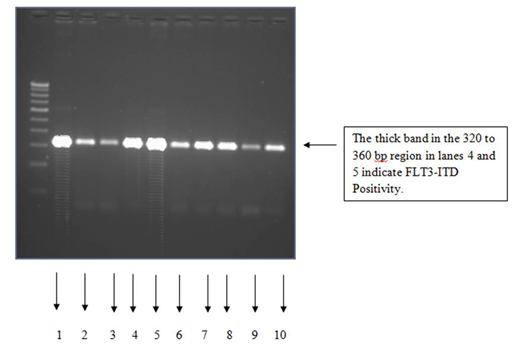Introduction: After introduction of Midostaurin, the importance of FLT3 mutation analysis in AML is irreplaceable. In this study we tried to find the incidence of this mutation in Indian Population.
Aims and Objective:
-To evaluate clinical parameters like age, sex, clinical presentation and duration of symptoms in atleast 60 de novo AML patients.
-Perform bone marrow examination, FAB subtyping and cytogenetic analysis in these cases.
-To estimate the prevalence of FLT3-ITD and FLT3-Asp835 mutations by DNA-PCR in these cases.
-To compare the FLT3-ITD and FLT3-Asp835 mutations status with clinical parameters and cytogenetics data.
Methods:
We Included:
-All cases of primary de novo Acute Myeloid Leukemia cases, who have not received any kind of chemotherapy for the same.
-Cases in whom adequate representative sample was available for cytogenetic analysis and PCR studies.
We excluded:
-All secondary Acute myeloid leukemia cases.
-Children less than 2 years of age.
-Patients who have received any chemotherapy before.
We did cytogenetics, Flowcytometry and RT-PCR based detection of FLT-3 as per standard protocol.
Results and Discussion:
In the time period between January 2015 to September 2016, a total of 68 Acute Myeloid Leukemia (AML) patients were admitted to our Institute and included in the study.
In the current study, the following observations were noted:
-Around 30% of patients referred to us with a provisional diagnosis of AML are not affording any further workup or treatment.
-The median age of occurrence of AML is much lower than in western countries.
-De novo cases are much more frequent.
-More than 80% of our patients presented with some form of bleeding with infections of variable severity in nearly 90% of patients.
-According to FAB classification AML-M2 was the most prevalent subtype in our study.
-Nearly 67% of our patients belong to Normal Karyotype followed by inv (16) and t(8:21) in around 10% of cases each.
-FLT3-ITD was present in 24% of cases and FLT3-Asp835 mutations were present in 6% of cases in concordance with reported literature.
-NPM 1 mutations were present in 24% of cases.
-NPM 1 overlapped with FLT3-ITD in 8% of the cases with one case showing overlap of NPM 1 AND FLT3-Asp835 mutation.
-At presentation FLT3-ITD positive patients reveal significantly high total count, low hemoglobin, low platelets and high Serum LDH values.
-All t(8:21) positive were negative for FLT3 mutations in this study.
-FLT3-ITD positivity correlated significantly with dim or no expression of immaturity markers namely CD34 and HLA-DR in Immunophenotyping.
-In our study 65.7% of patients achieved complete remission following standard induction
-Primary resistant disease was noted in 8% of cases (20% induction failure cases following one cycle of induction).
-2% of patients succumbed to induction related mortality with neutropenic sepsis being the major contributor.
-Induction failure significantly correlated with FLT-ITD positivity but no significant differences were noted in induction death.
-A 42% relapse rate is noted in our patients with >70% of them occurring within a year of therapy completion.
-4 % of our treated patients are alive during evaluation with median complete remission duration of 11 months.
-Most patients who had a relapse did not undergo further therapy and were referred back to their primary physicians for supportive care only. Since a meaningful survival analysis was not possible with most of these patients being lost to follow up, the overall survival data has not been reported.
-Only two patients underwent Allogeneic transplant and were alive during data analysis.
-Midostaurin was not available during study period and 30% of patients were put on Sorafenib.
Conclusion:
In conclusion the prevalence of FLT3 mutations in our population is similar to reported literature. Since patients who harbour FLT3/ITD have dismal outcome with standard therapy and considering the fact in India most patients are unable to afford treatment, patients should be encouraged to be a part of a clinical trial wherever possible. Although the complete response rates in our study are comparable to published literature, even patients who did not have any mutations had a poorer disease free survival compared to patients reported previously who were treated on a similar protocol without stem cell transplantation. Hence there is a need to study the biology of these patients looking at a wider range of genes which can have an impact on the outcomes.
No relevant conflicts of interest to declare.
Author notes
Asterisk with author names denotes non-ASH members.


This feature is available to Subscribers Only
Sign In or Create an Account Close Modal